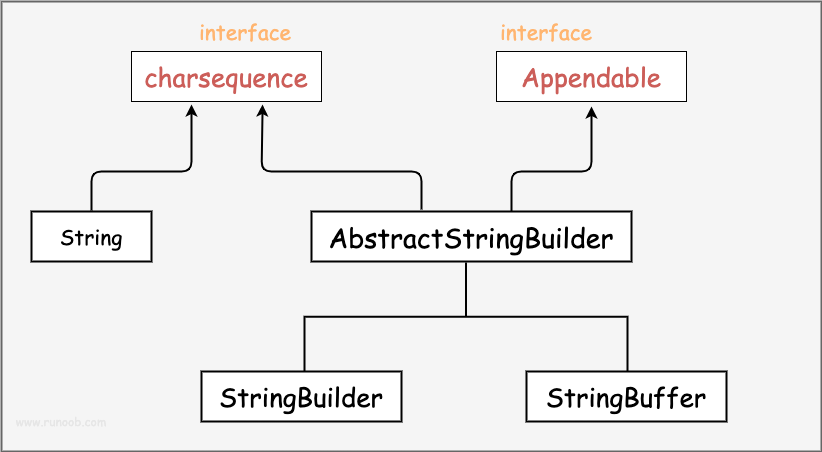JavaString
查找
-
char charAt(int index)
返回指定索引处的 char 值
-
boolean contains(CharSequence chars)
判断字符串中是否包含指定的字符或字符串
-
int indexOf(int ch )
int indexOf(int ch, int fromIndex)
int indexOf(String str)
int indexOf(String str, int fromIndex)
-
ch :字符,Unicode 编码。
-
fromIndex :开始搜索的索引位置,第一个字符是 0 ,第二个是 1 ,以此类推。
-
str :要搜索的子字符串
返回指定字符在字符串中第一次出现处的索引,如果此字符串中没有这样的字符,则返回 -1
-
-
int lastIndexOf(int ch)
int lastIndexOf(int ch, int fromIndex)
int lastIndexOf(String str)
int lastIndexOf(String str, int fromIndex)
- ch :字符。
- fromIndex :开始搜索的索引位置。
- str :要搜索的子字符串。
返回指定字符在此字符串中最后一次出现处的索引,如果此字符串中没有这样的字符,则返回 -1
属性
-
int length()
返回字符串的长度
-
boolean isEmpty()
如果字符串为空返回 true,否则返回 false。
替换
-
String replace(char searchChar, char newChar)
替换后生成的新字符串
-
String replaceAll(String regex, String replacement)
- regex – 匹配此字符串的正则表达式。
- replacement – 用来替换每个匹配项的字符串。
-
String replaceFirst(String regex,String replacement)
替换字符串第一个匹配给定的正则表达式的子字符串
拆分
-
String[] split(String regex)
String[] split(String regex, int limit)
- regex – 正则表达式分隔符。
- limit – 分割的份数。
-
public String substring(int beginIndex) public String substring(int beginIndex, int endIndex)
- beginIndex – 起始索引(包括), 索引从 0 开始。
- endIndex – 结束索引(不包括)。
返回一个新的字符串,它是此字符串的一个子字符串。
比较
-
int compareTo(String str)
按字典序,返回第一个不相同字符的ASCLL码的差值
-
int compareToIgnoreCase(String str)
按字典顺序比较两个字符串,不考虑大小写
-
boolean equals(Object anObject)
如果给定对象与字符串相等(指内容相同, == 比较的是地址是否相同),则返回 true;否则返回 false。
-
boolean equalsIgnoreCase(String anotherString)
比较内容是否相等,不考虑大小写
-
boolean contentEquals(StringBuffer sb)
字符串与指定 StringBuffer 表示相同的字符序列,则返回 true;否则返回 false
-
boolean endsWith(String suffix)
参数表示的字符序列是此对象表示的字符序列的后缀,则返回 true;否则返回 false
-
boolean startsWith(String prefix)
参数表示的字符序列是此对象表示的字符序列的前缀,则返回 true;否则返回 false
操作
-
String concat(String s)
将指定字符串连接到此字符串的结尾
-
String toLowerCase()
转换为小写的字符串
-
String toUpperCase()
转换为大写后的字符串
-
String trim()
删除字符串的头尾空白符
StringBuffer 和 StringBuilder
当对字符串进行修改的时候,需要使用 StringBuffer 和 StringBuilder 类
和 String 类不同的是,StringBuffer 和 StringBuilder 类的对象能够被多次的修改,并且不产生新的未使用对象。

由于 StringBuilder 相较于 StringBuffer 有速度优势,所以多数情况下建议使用 StringBuilder 类。
方法
-
StringBuffer append(String s) 将指定的字符串追加到此字符序列。
-
StringBuffer reverse() 将此字符序列用其反转形式取代。
-
delete(int start, int end) 移除此序列的子字符串中的字符。
-
insert(int offset, int i) 将
int参数的字符串表示形式插入此序列中。 -
insert(int offset, String str) 将
str参数的字符串插入此序列中。 -
replace(int start, int end, String str) 使用给定
String中的字符替换此序列的子字符串中的字符。 -
char charAt(int index) 返回此序列中指定索引处的
char值。 -
int indexOf(String str) 返回第一次出现的指定子字符串在该字符串中的索引。
- int indexOf(String str, int fromIndex) 从指定的索引处开始,返回第一次出现的指定子字符串在该字符串中的索引。
-
int lastIndexOf(String str) 返回最右边出现的指定子字符串在此字符串中的索引。
- int lastIndexOf(String str, int fromIndex) 返回 String 对象中子字符串最后出现的位置。
-
int length()
返回长度(字符数)。
-
void setCharAt(int index, char ch) 将给定索引处的字符设置为
ch。 -
CharSequence subSequence(int start, int end) 返回一个新的字符序列,该字符序列是此序列的子序列。
-
String substring(int start) 返回一个新的
String,它包含此字符序列当前所包含的字符子序列。- String substring(int start, int end)
返回一个新的
String,它包含此序列当前所包含的字符子序列。
- String substring(int start, int end)
返回一个新的
-
String toString() 返回此序列中数据的字符串表示形式。
类型转换
-
字符数组 -> String
-
copyValueOf
static String copyValueOf(char[] data)
static String copyValueOf(char[] data, int offset, int count)
-
offset : 子数组初始偏移量
-
count : 子数组的长度
返回指定数组中表示该字符序列的字符串
-
-
new String()
new String(char [])
-
-
String -> 字符数组
-
void getChars(int srcBegin, int srcEnd, char[] dst, int dstBegin)
-
srcBegin :字符串中要复制的第一个字符的索引。
-
srcEnd :字符串中要复制的最后一个字符之后的索引。
-
dst :目标数组。
-
dstBegin : 目标数组中的起始偏移量。
-
-
char[] toCharArray()
-
-
? -> String
static String valueOf()
返回给定类型参数的字符串表示形式